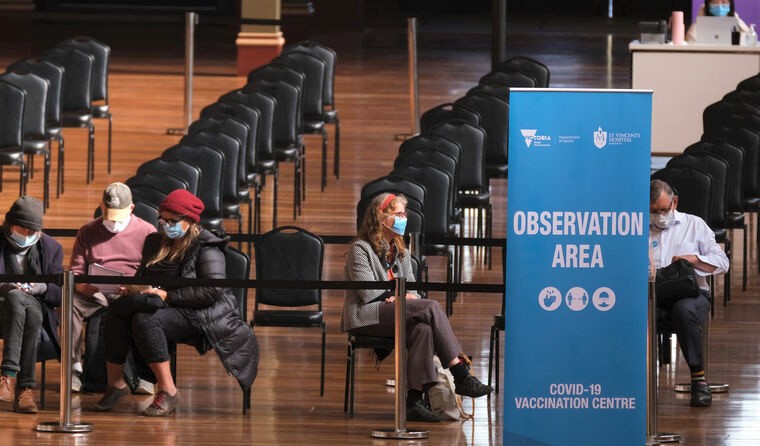News
How can Australia fix the issue of COVID vaccine maldistribution?
Undersupply has driven hundreds of general practices to quit the vaccine rollout as thousands of doses sit unused at mass vaccination clinics.
 A number of mass vaccination hubs are running well below capacity, while conversely many general practices still have long waiting lists. (Image: AAP)
A number of mass vaccination hubs are running well below capacity, while conversely many general practices still have long waiting lists. (Image: AAP)
General practice is undeniably the backbone of Australia’s COVID vaccination program.
Of the 512,000 doses administered last week, 293,000 – 57% – were delivered through primary care. And yet, many practices have the capacity to greatly expand on this number, if they had the supply, according to RACGP Vice-President Dr Bruce Willett.
‘There are two things constraining the rollout now and one is the maldistribution of the vaccine,’ Dr Willett told newsGP. ‘Practices like mine simply don’t have enough.
‘The other is vaccine hesitancy, and a more coordinated approach to that would be helpful.’
Even though more than 3.6 million vaccines have so far been administered in Australia, the rollout is roughly 10 million doses behind targets originally identified by the Federal Government before they were abandoned in April.
Meanwhile, around 200 general practices have left the COVID vaccination rollout since phase 1b began in March, a fact RACGP NSW&ACT Chair Associate Professor Charlotte Hespe has attributed to the ‘slow’ and ‘frustrating’ supply of doses to individual general practices.
But with a record 969,000 doses delivered to clinics and hubs around Australia last week, Associate Professor Hespe told newsGP pressure on demand could be eased if supply coordination improved, especially as some mass vaccination centres are operating well below capacity.
‘There are still a number of practices that haven’t had that certainty of supply and are still way off the numbers that they require to be able to meet their patient needs,’ she said.
‘So far, we haven’t really had the responsiveness from the Department of Health [DoH] about really addressing the issue and there’s a lack of tailoring for each practice’s capacity ... instead, they keep applying these generic formulas.
‘General practices are a complex beast, and you just can’t apply generic formulas. You need to take a patient-centered approach, and in this case it’s a community-centered approach.
‘So although they’ve increased supply, they haven’t addressed the actual core root problem of malalignment.’
Both Associate Professor Hespe and Dr Willett have called on the DoH to prioritise supply for local general practices over state and federal mass vaccination hubs, and to simplify the process of ordering and supplying vaccine doses.
‘The department should be able to ask practices what they need and then deliver it,’ Dr Willet said.
‘Then it’s a relatively simple matter to reconcile [the delivery] against the vaccinations that practices are giving and recording immediately on the NIP.
‘That data should be available and would make sure that practices are indeed using the vaccines that they’re getting.’
Dr Willett said such an approach – combined with more MBS support for GPs and allowing non-accredited practices and travel clinics to participate – would also help combat rising vaccine hesitancy.
‘The RACGP has been calling for funding of longer consultations to go through the issues with vaccination with patients, because I’ve certainly found that the vast majority of my patients, once I’ve explained the risks, are very happy to go ahead and have the vaccination,’ he said.
‘The more people we get to have the vaccination, so their friends and relatives can see that it wasn’t actually too bad, the more other people will be keen to go ahead and get it.
‘Every practice that’s able to give a flu vaccination should be able to give a COVID vaccination.’
Another reason coordination needs to improve, Associate Professor Hespe warns, is that it has been around nine weeks since phase 1b began and people will soon be returning to receive their second doses of AstraZeneca.
‘Not only am I going to continue to roll out my new patients for vaccine, I’ve also now got to start to accommodate those I’ve done the first round of and that’s actually going to get a bit sticky,’ she said.
‘There’s been no discussion about how we accommodate for them – the 150 [doses] I’m getting now is actually going to have to cover those who are second doses, as well as first doses.
‘At this stage, it’s very clear that even though there is still some vaccine hesitancy, general practice is the right place to talk that through and to roll out the vaccine.
‘We just aren’t being supported to be able to really up the ante.’
Should Australia maintain its current pace of around 510,000 doses per week, it will take until October 2022 for every eligible Australian to receive a COVID vaccine.
Log in below to join the conversation.
coronavirus COVID-19 vaccine rollout
newsGP weekly poll
Health practitioners found guilty of sexual misconduct will soon have the finding permanently recorded on their public register record. Do you support this change?